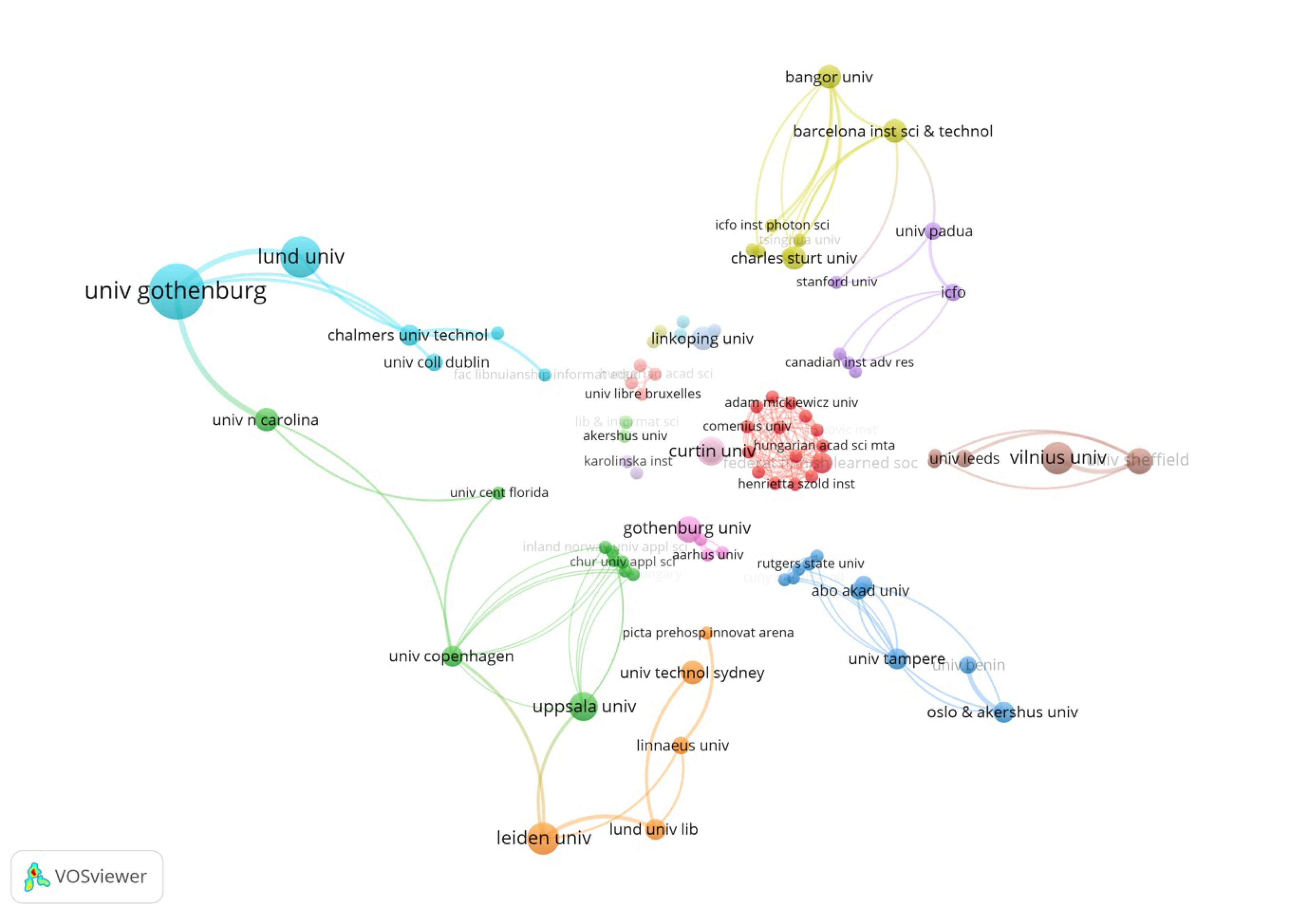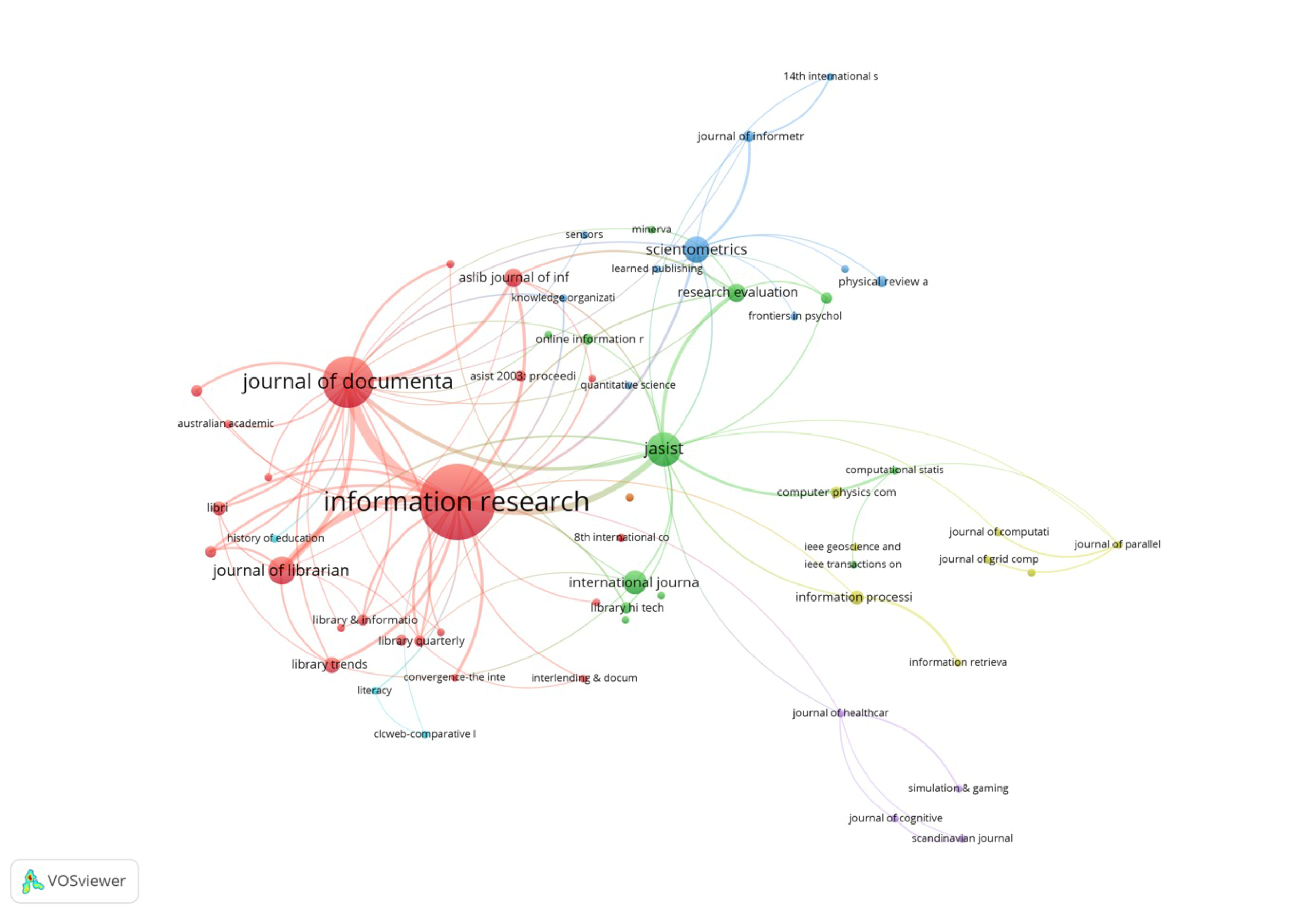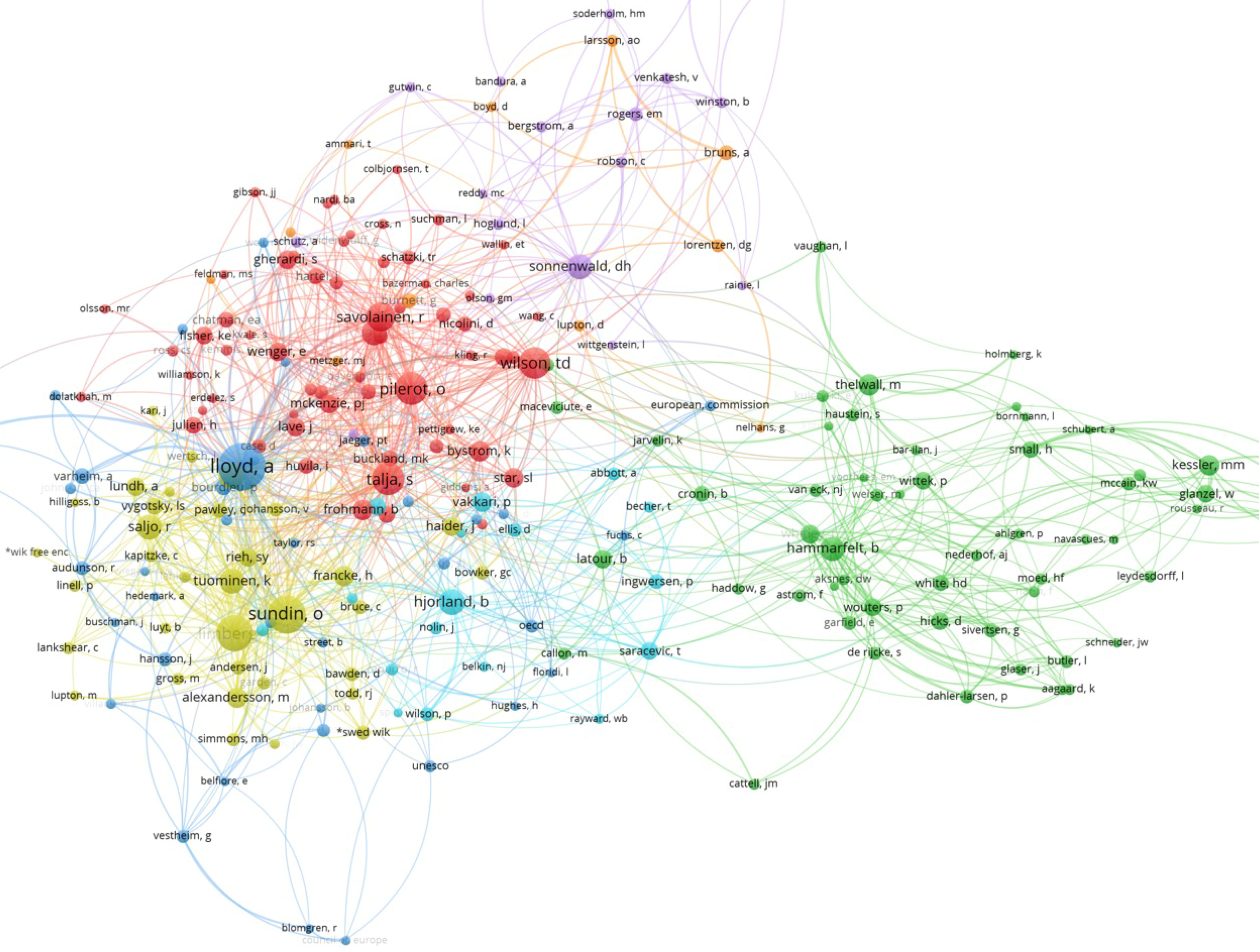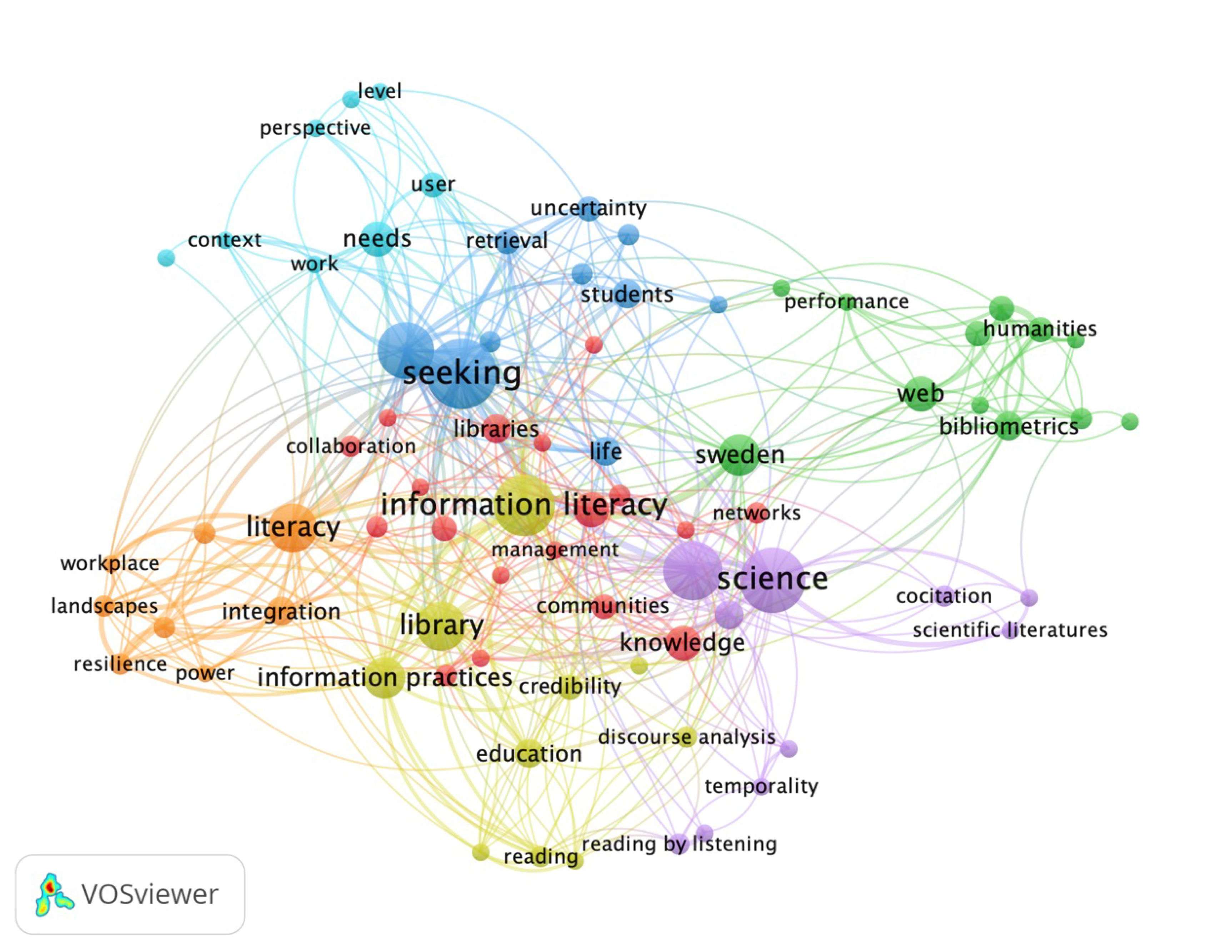

Abstract
Introduction. The aim of the article is to convey an overall picture of the research conducted at Swedish School of Library and Information Science (SSLIS).
Method. The documents for the analyses were found in the DiVA – a national publication registry of Swedish universities and in the international citation database Web of Science. The authors have searched DiVA for publications indexed under the Department and performed a manual review of authors’ names. Searches were made for authors’ names directly in Web of Science.
Analysis. A portrait of research production was created using descriptive statistics and more sophisticated analysis was used for 240 publications found in the Web of Science.
Results. The results present the production and cooperation patterns of SSLIS researchers, the subjects covered by them, the relations between researchers, journals and research contents.
Conclusion. Overall, SSLIS appears as a broad and dynamic environment where research follows firmly established tracks and simultaneously explores current phenomena and practices.
A common gift on anniversaries, such as a 50-year birthday, is a portrait of the person celebrating the anniversary. When the Swedish School of Library and Information Science (SSLIS) celebrates 50 years, we want to draw attention to this event with a bibliometric portrait of the research conducted over the years. Memoirs and more traditional accounts of an institution’s history are valuable and provide a detailed insight into significant events. Our contribution is not aimed at such insights but rather to convey an overall picture of the research conducted at SSLIS. Such a portrait is of necessity partial and limited. Still, it is nonetheless of great interest for an organisation whose somewhat boastful English name – “The Swedish School of Library and Information Science” – indicates that we want to be a significant player in the international arena. For SSLIS’s reputation and international influence, the publications we pay attention to here are significant as English-language articles have become an increasingly important communication channel within Library and Information Science.
The bibliometric portrait is based on publications indexed in DIVA – a national publication registry of many Swedish universities – while the more detailed analysis uses articles in the international citation database Web of Science (WoS) as its primary material. This means only research published in journals is included in the latter analysis, while Swedish material, monographs, book chapters and reports, and more popular scientific material are excluded.
The study includes all items reported by the school’s staff in the universities’ publication database DiVA between 1973 and June 2022. It may appear simple to find all publications from SSLIS, yet over the years, more than 40 significantly different ways to indicate institutional affiliation have been used. Moreover, authors may change affiliations or names, so we needed to remove duplicates and standardise data before any actual analysis could be done. The inclusion of documents was done using three strategies:
By searching in DiVA for publications indexed under the Department of Library and Information Science or SSLIS.
A manual review of names was then made to ensure that all publications by employees belonging to the SSLIS were included. This procedure ensured that researchers who have worked at SSLIS but did not index their publications correctly in DiVA were included.
In addition, supplementary searches were made for author names directly in Web of Science, which resulted in an additional number of identified publications.
In total, our selection resulted in 1,871 records found in DiVA. Of these, 240 articles authored by SSLIS researchers were found in Web of Science. Hence, it should be noted that the more detailed analysis of citation patterns and collaborations is based on this smaller selection. The total production of publications is shown in Table 1.
| Publication type | Other (third-stream publications, etc.) | Other research publications | Peer reviewed publications | Total |
|---|---|---|---|---|
| Journal article | 79 | 78 | 337 | 494 |
| Journal article, review | 14 | 1 | 15 | |
| Journal article, book review | 45 | 236 | 10 | 291 |
| Book | 22 | 2 | 24 | |
| Doctoral dissertation, monograph | 48 | 48 | ||
| Doctoral dissertation, composite | 7 | 7 | ||
| Chapter in book | 9 | 177 | 50 | 236 |
| Conference paper | 6 | 214 | 212 | 432 |
| Licentiate dissertation, monograph | 5 | 5 | ||
| Manuscript (preprint) | 1 | 1 | ||
| Proceedings (as editor) | 1 | 2 | 3 | |
| Report | 14 | 92 | 7 | 113 |
| Anthology (as editor) | 1 | 14 | 6 | 21 |
| Other | 160 | 6 | 15 | 181 |
| Total | 315 | 914 | 642 | 1,871 |
Table 1: Publication type overview
An overview of the content of the publications offers an image of the distribution between peer-reviewed and other scientific articles, as well as publications aimed at the general public and the profession (Figure 1).

Figure 1: Publication category over time (five-year interval)
The careful reader will notice that we do not cover the entire 50-year history of SSLIS. However, the bibliometric data shows that SSLIS as a research institution is significantly younger than that, with the mid-1990s appearing as an appropriate starting point (for a broader history of LIS in the Nordic countries, see Åström 2008). Nationally, this is also when library and information science is established as its scientific discipline. Regarding the publication category, publications classified as scholarly, with or without review1, have been the primary publication category since the mid-1990s. Of course, there were scientific approaches earlier than that, but these are so rare that a bibliometric analysis is not possible.
English was the primary publication language during the 2000s. In addition to Swedish, there are also Nordic languages, the major European languages, and publication languages that correspond to the mother tongue of academics employed at SSLIS: Lithuanian (16 publications) and Hungarian (2 publications) (Figure 2).

Figure 2: Overview of publication languages 1973–2022
Carrying out advanced bibliometric analyses based on DiVA data is difficult, as this data is not quality controlled and standardized in the same way as in international citation databases. In addition, DiVA does not contain information about citations, which limits the possibility of more in-depth analyses. In what follows, we restrict the investigation to the 240 publications found in Web of Science2. As noted above, these publications constitute a small part of the total publications produced (240 out of 1,871). A detailed analysis of this material may nevertheless be justified, given that this is the research which, to some extent, is “visible” when outsiders want to get an overview of the research activities at SSLIS. Moreover, these publications count in various forms of evaluation and resource allocation models applied at the national level.
There are many ways to assess research activities, often presented in statistical tables that easily fall victim to simplified rankings. In what follows, based on established measures and tools available in the field of bibliometrics, we will try to draw a picture that focuses on exploring the institution’s research rather than evaluating it and its authors. However, this does not mean that we refrain from presenting both individuals and themes that appear in the material, but it is worth noting that this is not the focus of the investigation.
To offer a first overview, we present the 25 authors who appear most clearly in the analyzed material below. The presentation gives a historical view of when a researcher was active in the department (Figure 3). The nodes symbolize publications, size and color shifts, and rate; these indicators also determine the order in which the authors are presented. Note that it is pblications indexed in WoS with at least one author at SSLIS are reproduced here. For example, Sarah de Rijcke (second at the bottom of the list) has never been employed at SSLIS but has co-authored with researchers at the department. Similarly, Åse Hedemark, which we find below, has mainly been active in Uppsala but with extensive collaboration with SSLIS. Additionally, researchers who recently started their employment at SSLIS – but have produced extensively elsewhere – are omitted from the list.

Figure 3: 30 authors’ publishing profiles over 25 years. The horizontal line shows the period over which the author has published. The size and intensity of each node reflect the citation rate per year
The figure highlights the duration of time during which the author was actively engaged in research (published) at SSLIS. Louise Limberg stands here in a class of her own with a more than 20-year series of publications, followed by Katriina Byström.
The output of the individual authors says something, at least for the initiated, but the patterns become much more interesting when we include how SSLIS researchers collaborate (Figure 4). The figure displays researchers who often collaborate (co-author) close to each other. The clusters, depicted in the figure using the same colour scheme, can reveal thematic interests among the researchers. These clusters can vary in specificity, with some being more narrowly focused (located in the periphery) while others are more broadly connected to other clusters (central groups with many interconnections).

Figure 4: Co-authorship at SSLIS, 1997–2022
So let’s delve into this colorful assortment of clusters. Starting from the left, we find some pink nodes where Lloyd and her former PhD student Hicks are included. Next, we see a turquoise group of information practitioners (Hultgren, Pilerot, Lindberg, and Hedemark) and a brown and orange cluster with similar interests (Lundh, Limberg, Sundin, and Haider). A group studying cultural policy (Johannisson and Blomgren) has also been placed here. Francke (peach-colored) links several clusters together and leads us up to the blue “Sonnenwald group”. Below we find a green crowd, with Byström at the head, who find information management within organizations particularly interesting. Above them looms a purple cluster centered around Maceviciute and Wilson. What then remains is the red group, where Nolin forms a central node, surrounded by co-authors. Below this is a yellow bibliometric cluster where Hammarfelt occupies a central role. The many links between all these groups deserve special attention, and the illustration clearly shows a cohesive research environment with many connections between authors and clusters.
But we do not only collaborate internally. If we aggregate the data at the global level, it turns out that the Library School has a distinctly international profile with collaborations, including 30 countries from all continents. Of 469 co-authors, 152 (~32%) come from other countries. The most frequent collaborations occur with Australia and Great Britain (18), Lithuania (16), the USA (14), Finland (11) and Norway and Spain (10 each) (Figure 5).

Figure 5. Co-authorship at the global level
The following pattern emerges if we focus on institutions rather than countries (Figure 6). SSLIS has been excluded from the analysis and is not visible in the visualization. The most coherent component shows considerable collaboration with other Information studies departments in Lund, Uppsala, Oslo and Copenhagen. Not surprisingly, geographically close universities such as the University of Gothenburg and Chalmers University of Technology are included. Due to the threshold for inclusion being set at one contributing publication, a particular pattern appears in the red cluster where an article published with contributions from many European universities forms a circular group.

Figure 6: Co-authorship between authors within 103 organizations
So far, we have predominantly discussed production and collaboration patterns, yet where research from SSLIS has been published is also of interest. Two prominent journals in the material indexed in WoS are the Information Research and Journal of Documentation. Other significant journals are Scientometrics, JASIS(T) in its many name iterations, the Journal of Librarianship and Information Science, and the International Journal of Cultural Policy (Figure 7).

Figure 7: Bibliographic coupling at the journal/source level. 67 sources in all
In general, it can be said that the red cluster represents a more traditional library science publication. At the same time, the green one stands for an information science orientation that slips into more computer science oriented subfields.
But how does research conducted at SSLIS relate to a broader intellectual landscape? This can be analyzed by looking at the researchers that authors at SSLIS most frequently refer to. They make up what in bibliometrics lingo is called the “intellectual base” (Persson 1994). A co-citation map at the author level gives us a multitude of names but also the opportunity to thematize the research that SSLIS researchers build upon. The size of the nodes shows how many times the author appeared in reference lists in the material, and the colors of the clusters show how they are related thematically. Starting from the top, we find a purple field where Sonnenwald, a former professor at SSLIS, and Lars Höglund, the fields first Swedish professor, are included. Below this follows a red group where information search and information practices are central themes. The same can be said to apply to the yellow cluster. Moving to the left, we find cultural policy research at the bottom, then Nordic B&I. This includes many researchers who either have an intellectual background in B&I (Hedemark, Limberg, Sundin, Hanson, Francke) or collaborated closely with SSLIS (Alexandersson, Säljö). In the upper parts of the figure, two different clusters overlap, medically oriented information research (Söderholm) and methodological research focused on the internet and social media (Gunnarsson Lorentzen), as well as internationally recognized authors such as boyd and Bruns. Finally, in the green cluster on the right, the broad informetrics area focuses on bibliometrics and webometrics, where Hammarfelt stands out among local authors. At the same time, Garfield, de Rijcke, and Leydesdorff are just a few of the most highly cited researchers appearing in the international field (Figure 8).

Figure 8: Co-citations aggregated at the author level. 5,201 authors in total, 240 (238 belonging to the largest component of the set) with ≥ 5 citations. Note, self-citations have not been removed
But what, then, is SSLIS research really about? We could read everything written at SSLIS for 50 years to answer this question. However, that meant it would be finished in time for the 75th anniversary. Instead, we analyzed the authors’ keywords and constructed a map based on how they are used. Figure 9 presents the keywords that make up the largest coherent component of the material. In short, two keywords that describe the same article are linked together, which enables a mapping of the thematic focus of research at SSLIS.

Figure 9: Commonly occurring keywords at SSLIS and their co-occurrence, 1997–2022. The visualization shows subject words that appear ≥3 times in the material
The astute reader can certainly observe some similarities between this visualization and the co-authorship map (Figure 4). Concepts related to information seeeking dominate, while the green and purple cluster represents a partially different orientation with science and bibliometrics as key terms. Among the more prominent directions we find research on “literacy”, “credibility”, “reading”, “needs”, and of course, “library”.

Figure 10: Thematic map of the degree of development and relevance based on 750 keywords and visualized with the Louvain algorithm
Finally, we present a more forward-looking analysis. Our thematic map (Callon, Courtial & Laville, 1991) (Figure 10) is based on analysing the proximity between clusters of co-occurring keywords in the material. Simply put, each cluster (node) receives a measure of relevance based on how central the concepts are regarding network measures. In contrast, the degree of development is measured in relation to how often the words appear in the material. The schematic four-field model offers the opportunity to identify the nature of the clusters. In the lower right corner, there is the established basic research (“information practices”, “reading”). In contrast, in the upper right corner, there is the research that is undergoing the fastest development (“audiobooks” and “information management”. In the lower left quadrant themes that are either on the way or the decline are represented, while the niche terms in the upper left corner may be described as topics which are not central to the field of LIS.
A good portrait should reflect what is depicted, and we hope many recognize the image of SSLIS presented here. At the same time, we wish that the readers have uncovered new aspects of the subject being portrayed. Overall, SSLIS appears as a broad and dynamic environment where research follows firmly established tracks and simultaneously explores current phenomena and practices. It is a lively 50-year-old who probably has her best years ahead of her. Remember Library and information science, SSLIS, and the University of Borås are still very young in relation to many traditional disciplines, subjects and universities — strikingly so if we consider that actual research has been conducted perhaps only in the last 30 years.
The authors wish to thank Elena Maceviciute and Thomas Wilson for inviting us to publish this commemorating piece in Information Research. We also want to extend our gratitude to all students, teachers and researchers which have contributed to the success of the Swedish School of Library and Information Science during its first 50 years.
Gustaf Nelhans obtained his PhD in theory of science in 2013 and is associate professor at the Swedish School of Library and Information Science (SSLIS) at the University of Borås, Sweden. His research primarily revolves around the performativity of scientometric indicators, particularly exploring the theory, methodology, and research policy aspects of scholarly publications within the context of scientific practice using a science and technology studies (STS) perspective. He can be contacted at gustaf.nelhans@hb.se
Björn Hammarfelt is an associate professor at the Swedish School of Library and Information Science (SSLIS), University of Borås. His research is situated at the intersection of information studies and sociology of science, with a focus on the organization, communication and evaluation of research. Hammarfelt’s most recent work has focused on evaluation practices in academia, with particular emphasis on bibliometric measurement and its effects on knowledge production and working conditions. He can be contacted at bjorn.hammarfelt@hb.se
This paper was originally published, in Swedish, as a chapter in the volume commemorating the fifty years anniversary of the founding of the Swedish School of Library and Information Science (Limberg, L. & Ögland, M. (2022). Från analog katalog till digital portal. Bibliotekshögskolan 50 år. Borås, Sweden: Högskolan i Borås). I was not aware of any other paper that had presented a bibliometric analysis of the output of a single school in this field and felt that it deserved a wider international audience. Perhaps it will prompt the production of similar studies of other leading research schools.
Åström, F. (2008). Formalizing a Discipline: The Institutionalization
of Library and Information
Science Research in the Nordic Countries. Journal of Documentation,
64(5), 721–737. https://doi.org/10.1108/00220410810899736
Callon, M., Courtial, J. P., & Laville, F. (1991). Co-word analysis as a tool for describing the network of interactions between basic and technological research: The case of polymer chemistry. Scientometrics, 22, 155–205. https://doi.org/10.1007/BF02019280
Garfield, E. (2009). From the science of science to Scientometrics visualizing the history of science with HistCite software. Journal of Informetrics, 3(3), 173–179. https://doi.org/10.1016/j.joi.2009.03.009
Persson, O. (1994). The intellectual base and research fronts of JASIS 1986–1990. Journal of the American society for information science, 45(1), 31–38. https://doi.org/10.1002/(SICI)1097-4571(199401)45:1<31::AID-ASI4>3.0.CO;2-G